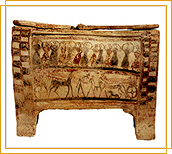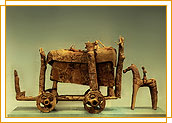Athletic events as a component of funerary practices
Various
scenes on vases from the Homeric period (8th century BC) lend
credit to the funerary  character
of chariot racing: often in the two or three zones of the
same amphora, mourning women are accompanied by chariots.
Even though, athletic games during this period did not exclusively
form part of funerary practices, it is still a question of
how they ended associated with them. Different opinions offer
alternative interpretations for the origins of the custom: character
of chariot racing: often in the two or three zones of the
same amphora, mourning women are accompanied by chariots.
Even though, athletic games during this period did not exclusively
form part of funerary practices, it is still a question of
how they ended associated with them. Different opinions offer
alternative interpretations for the origins of the custom:
It
was through athletic competition that the heir of the dead
warrior was originally selected. Such competition, held  immediately
after the loss of the leader, would allow not only credible
selection of the successor through fair competition, but cessation
of the hostilities as well. Peaceful competition, thus might
have sprung from needs dictating military competition. immediately
after the loss of the leader, would allow not only credible
selection of the successor through fair competition, but cessation
of the hostilities as well. Peaceful competition, thus might
have sprung from needs dictating military competition.
In
addition, the games held in the memory of the dead functioned
as rites of passage, demarcating the separating line between
the living and the dead and reintegrating the community. In
that sense, the games symbolized the renaissance of life.
|
